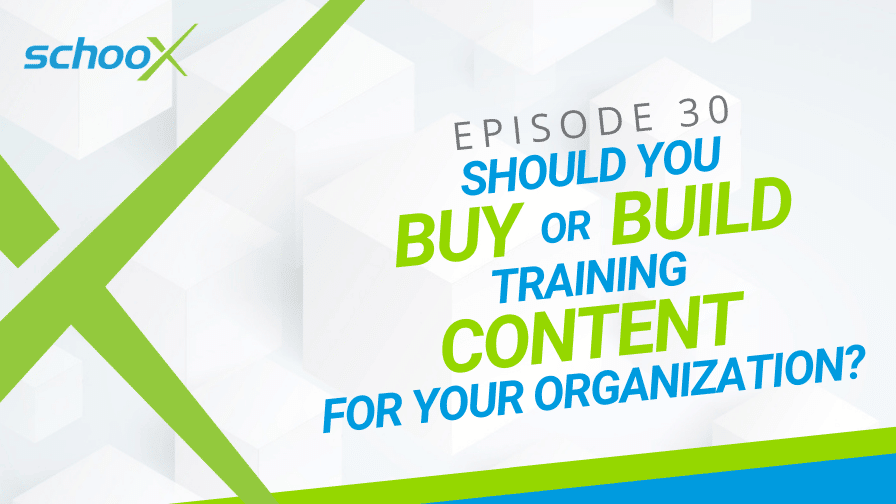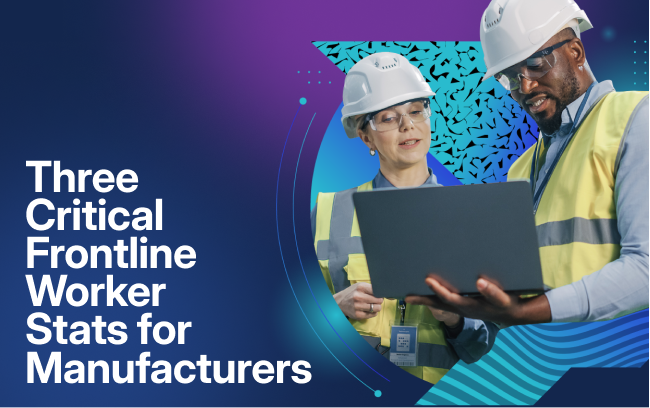May 11, 2021
7 Min. Read

Are you looking for a new training solution for your organization?
One of the first decisions to make is: will you buy a solution from a third party or design your own? There are pros and cons to either option, and your choice will likely depend on budget, time available, and your existing skills and resources.
A common solution is to use a mixture of both by purchasing training and then adding your own context on top to connect the dots.
In this episode of The Learning Xchange, Schoox’s Matthew Brown (VP of Learning and Brand Success) delves into the topic of bought versus built training content. Matthew shares his tips for making bought training solutions more effective and relevant for your team.
Listen to the podcast episode below to learn more or keep reading.
Buying versus building
Those who have been in the learning and development space for a while may remember the switch between bought and built content. Back in the 2000s and before, there was a great emphasis on buying content from third-party providers.
In the 2010s, people started to focus on building content instead because they wanted it to sound like them. Businesses placed more value on content that was in keeping with the brand and employee culture.
Then 2020 happened and created a massive wave of changes in the learning and development world. It brought businesses closer to the middle ground as they began to consider a hybrid approach.
People started to ask, can we make bought and built content work together?
The simple answer is yes, but how do you do this in a way that makes sense? The last thing anyone wants is a convoluted training system that requires employees to log into a dozen different systems. That’s not good for the employee, nor is it good for you in terms of tracking progress and effectiveness.
Start with an anchor
When weighing up which type of solutions to apply to your organization, the very first step is to start with an anchor based on the existing skills, competencies, and resources available. Assess what your business needs, what it already has, and what the focus of your training will be.
Don’t skip this step. If you invest a little time in this, you can progress with your training solutions much faster in the future. It enables you to learn and understand what your knowledge is today, where the gaps are, and how you can fill those gaps quickly.
It also helps you identify where your resources should be split. In this stage, it’s good to figure out how long it takes for you to build a training course. With that information, you can make a more informed decision on whether to buy or build content.
Reserving your energy and resources
There’s no harm in buying content for your organization. Not everything needs to be built according to your exact requirements. There are plenty of fantastic training resources out there.
It doesn’t even have to look or feel the same in terms of company culture or when compared to your other training resources. All it needs to do is articulate a message to the learner.
Particularly in this trying year, perhaps we should be reserving our energy and resources that we would usually spend on building our own content.
Here’s an example of what you could do with pre-built content.
Let’s say you buy customer service training for your workforce. This could be content that many successful businesses use. It could have great methodology.
However, maybe the look and feel of the content don’t quite fit with your business. Maybe the people in the training videos wear suits and ties, and your organization is much more laid back. You might worry that the content won’t have the same effect on your employees.
The goods news is that if the methodology and the content are good, you can work with that. Buy it, then spend some time and energy on building additional content that connects the dots for people.
Using that pre-built customer service course to teach all the basic mechanics and foundational elements saves you from spending hours building that course yourself. Rather than starting from scratch, you could focus on additional content such as a course or presentation that brings that pre-built content into the context of your business.
Internal communication about buying new content is key
For this to work, you need to have a well-thought-out internal communication and marketing plan. By this, we mean a way to help everyone understand what you’re trying to do with the learning content and why.
This could be a good spot to just go ahead and talk about the elephant in the room. When talking to your employees, give them a warning that you’re launching a bunch of new content, and not all of it will be what they’re used to. It may feel out of context for the business, but it’s also really valuable content.
Being transparent about this can help to set expectations and trust that the content isn’t just a random course.
Think about the user experience
Another consideration when buying content is to look at the user experience. No one likes the idea of buying a bunch of content that simply doesn’t work in your system, forcing you to direct employees to multiple sources. Without a central way to keep everything together and track the learning progress, it can become a big headache.
There are solutions out there, integrations that you can use to make things seamless for your users. The problem is that those integrations and tools cost money and time. Sometimes they can even overcomplicate the journey.
That’s not to say you shouldn’t try to make the experience seamless. Instead, start with the end in mind.
Consider what solution you need, speak with different providers, and get an understanding of the possible technical limitations before you jump in headfirst and purchase the content. Get a clear picture of what you want to achieve first, and then work backward to find a solution that works for everyone.
Setting clear expectations when you buy new content
One of the most important things to do when you buy content is to set clear expectations with your employees. They need to know what to expect.
For example, if you were looking to purchase a house and a realtor showed you around a home with holes in the wall and an unfinished floor, you probably think, “this isn’t for me.” However, if, before you went in, the realtor gave you a rundown of what needed to be done and when it’d be done, this would be completely different. You would walk inside with clear expectations.
The same applies to training courses that aren’t 100% perfect or tailored for your organization. They may not reflect your company culture or cover everything you need them to cover, but you can put the finishing touches on them. You can let employees know what to expect and why.
Instead of spending time and energy building bespoke solutions from the ground up, you can simply fill in the gaps, set clear expectations, and ensure that your learners are prepared and open to learning.
When you buy training solutions, it isn’t just about the cost or the content itself. It’s about how you present it to your learners. When we get the communication right, we can help people understand what you’re doing and why. That will go a long way in making the learning experience smoother and more effective.



